Excursions
Discover St. Colomon pilgrimage church and the culture of neigbouring Füssen.
You will see just how much there is to discover!
Schwangau area
A royal holiday
The Schwangau area is like a dream, nestling at the foot of the imposing Alpine ridge, it has a “healing” climate and is surrounded by four crystal-clear lakes and world-famous castles. You can walk along former royal bridle paths in the Ammerwald National Park, or take in the spectacular views from the mountain trails. They will let your spirit soar! Body, mind and soul can simply breathe in the unspoilt nature here. You will have a wonderful time in the Königswinkel [Royal Nook].
Attractions & culture
Füssen museum
The museum is located in the former abbey of St. Mang. You will find out many interesting facts about the town of Füssen here. There are archaeological finds from the abbey’s history, baroque rooms, such as the old library which houses numerous valuable books, and the royal hall, which also serves as a concert venue. An important part of Füssen’s history is its role in lute and violin making, and the town is seen as the cradle of European lute and violin making. The museum also gives you access to Bavaria's oldest example of the Dance of Death [Totentanzzyklus] in St. Anne’s Chapel.
St Stephen’s church and Franciscan monastery in Füssen.
The Franciscan monastery was built in 1629. The former municipal church was given to Franciscan friars, who had been called to Füssen from the Tyrol, in 1628 during the counter reformation following a short absence of the Jesuits. Monks still live in the monastery today.
Via Claudia and the “Romantic Road”
The Via Claudia starts at the river Po in Italy and from there leads across the Alps. It was one of the most important trading routes for the Romans. The southern portion of the “Romantic Road” ends in Füssen.
St. Mang’s church and former abbey.
The Benedictine abbey near St. Mang was founded in the 9th century AD. Monks lived there until secularisation in 1802/03. They were excellent artists and scientists. The impressive baroque architecture of the abbey and today’s municipal parish church are well worth a visit.
St. Coloman’s church
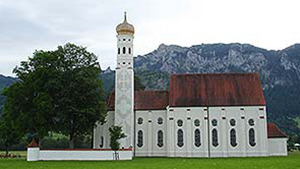 The delightful baroque church stands in the shadow of an ancient tree. It is dedicated to St. Coloman, the patron saint of livestock. The traditional Colomon Festival is held annually on the second Sunday in October.
The delightful baroque church stands in the shadow of an ancient tree. It is dedicated to St. Coloman, the patron saint of livestock. The traditional Colomon Festival is held annually on the second Sunday in October.
Lech Waterfall [Mangfall]
The river Lech has carved a path through the Lusalten rocks in the “Ziegelwies” area of Füssen and then falls into the depths as a waterfall. The “Maxsteg” leads across the ravine. It is named after King Maximilian II. A bust has been carved in the rock face opposite in his honour. You will find the so-called “Magnustritt” above a small parking area, where St. Magnus [Mang] is said to have left his footprint when he jumped across the river Lech.
Lakes
Alpsee
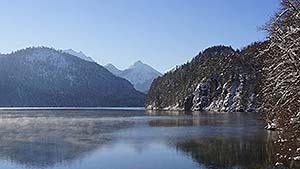 This romantic lake is surrounded by forest and mountains and located close to the Bavarian royal castles at an elevation of 814 m. The clear water of the lake invites you to swim or just contemplate. The lake is 62 metres deep, and its water is so pure that it is fit to drink.
This romantic lake is surrounded by forest and mountains and located close to the Bavarian royal castles at an elevation of 814 m. The clear water of the lake invites you to swim or just contemplate. The lake is 62 metres deep, and its water is so pure that it is fit to drink.
Swan Lake and Swan Lake Park
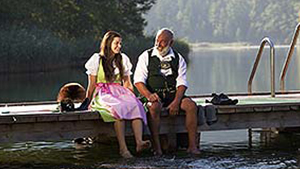 The idyllic Swan Lake [Schwansee] is situated in the lovingly designed Swan Lake Park [Schwanenseepark] and is a popular bathing lake. Visitors come throughout the year to walk in the wild flower meadows of the nature reserve that surrounds the lake. There are signed trails for joggers and walkers. In winter, iceskaters and Bavarian curling enthusiasts have fun on the frozen lake, which can also be reached by a cross-country skiing trail.
The idyllic Swan Lake [Schwansee] is situated in the lovingly designed Swan Lake Park [Schwanenseepark] and is a popular bathing lake. Visitors come throughout the year to walk in the wild flower meadows of the nature reserve that surrounds the lake. There are signed trails for joggers and walkers. In winter, iceskaters and Bavarian curling enthusiasts have fun on the frozen lake, which can also be reached by a cross-country skiing trail.
Lake Forggensee
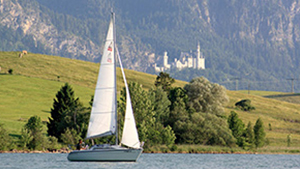 Sails glide peacefully in front of the mountain silhouettess. The 12 km long and 3 km wide reservoir was constructed on the River Lech in 1954 (highest water level from early June to the end of October). The lake is an eldorado for water sport fans. There are well-designed bicycle paths inviting you to go for a ride along its shores.
Sails glide peacefully in front of the mountain silhouettess. The 12 km long and 3 km wide reservoir was constructed on the River Lech in 1954 (highest water level from early June to the end of October). The lake is an eldorado for water sport fans. There are well-designed bicycle paths inviting you to go for a ride along its shores.
River Lech
The river starts its journey as a small mountain spring in the Austrian Lechtal Alps. Its current course and valley were created in the last ice age, giving the “Lechfeld” its characteristic landscape. The name is supposed to mean “the fast flowing one”. It tumbles and crashes into the depths at Bad Faulenbach. Then its turquoise waters make their way through Lake Forggensee until they reach Donauwörth, where the 247 km journey ends as the river joins the Danube.
Bannwaldsee lake
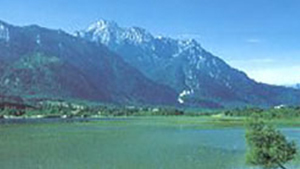 The Bannwaldsee lies in the middle of a nature reserve. On still days, the Pfronten and Tannheim mountain ranges can be seen reflected on the lake’s surface. The odd pedalo or rowing boat potter about on the water during the summer. Reeds cover the northern shore of the 20 m deep bathing lake. The Bannwaldsee campsite with its modern facilities and beautiful places to take a dip is located on the southern shore of the lake.
The Bannwaldsee lies in the middle of a nature reserve. On still days, the Pfronten and Tannheim mountain ranges can be seen reflected on the lake’s surface. The odd pedalo or rowing boat potter about on the water during the summer. Reeds cover the northern shore of the 20 m deep bathing lake. The Bannwaldsee campsite with its modern facilities and beautiful places to take a dip is located on the southern shore of the lake.
Mountain huts
Bleckenau lodge
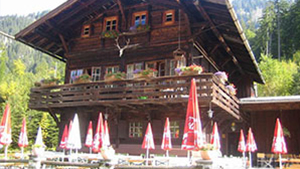 Mountain guesthouse Bleckenau is in King Ludwig’s former hunting lodge.
Mountain guesthouse Bleckenau is in King Ludwig’s former hunting lodge.
Drehhütte
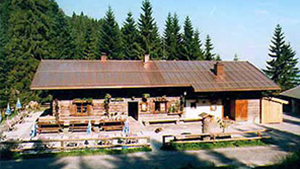 A popular destination for big and small, come rain, snow and sunshine!
A popular destination for big and small, come rain, snow and sunshine!
www.drehhuette.de
Tegelberghaus
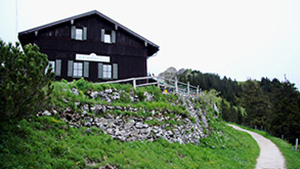 This former royal hunting lodge was built in 1835 by Maximilian II., the father of Ludwig II.
This former royal hunting lodge was built in 1835 by Maximilian II., the father of Ludwig II.
www.tegelberghaus.de
Horse drawn carriage and sledge rides
Horse-drawn carriage Josef Kotz Schwangau - Brunnen
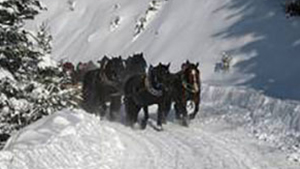 Enjoy the beautiful dreamy landscape of the Schwangau area in the calm and comfort of a horse-drawn carriage or sledge.
Enjoy the beautiful dreamy landscape of the Schwangau area in the calm and comfort of a horse-drawn carriage or sledge.
By reservation only. Contact:
Josef Kotz, Seestr. 74, Brunnen, Tel. + 49 [0]8362 8581
Kutschbetrieb Otto Kotz Schwangau
Otto Kotz, Unterdorf 5, Tel. + 49 [0]8362 8094
Kutschbetrieb Heinrich Vogtmann Schwangau - Horn
Heinrich Vogtmann, Feilitzschpark 9, Tel. + 49 [0]8362 9268685
Within 100 km of Bannwaldsee campsite
Füssen
3 km
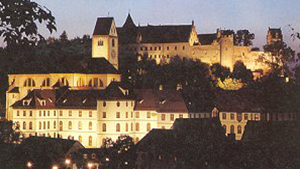 Experience the romance of medieval Füssen, the nearest town.
Experience the romance of medieval Füssen, the nearest town.
Kempten
45 km
Kempten is the principal town of the Allgau region, and one of the oldest towns in Germany. Campodunum Archaeology Park is a witness to history.
Oberammergau
approx. 50 km
Although world-famous for its passion play, its houses with walls adorned by traditional paintings and artistic wood carvings alone are well worth a visit.
Oberstdorf and the Kleinwalser Valley
approx. 60 km
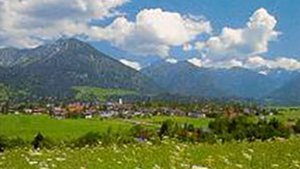 A beautiful day trip destination in summer, autumn and winter.
A beautiful day trip destination in summer, autumn and winter.
Munich – A metropolis with heart
approx. 100 km
Bavaria’s capital city is one of Germany’s favourite places to visit. Must sees are the Deutsches Museum, Olympia Shopping Centre, the Hofbräuhaus, the Zoo and the October Beer Festival. There are also plenty of concerts and theatre performances that make Munich such an inviting destination.
Augsburg
approx. 100 km
Situated directly on the “Romantic Road”, the “Fugger City” is a cultural destination with a variety of attractions from the various eras of its 2000-year history.
Innsbruck – the capital city of Tyrol (Austria)
approx. 100 km
Visit the capital city of the Tyrol with its magical old town, the Golden Roofs [Goldenes Dachl] and the Bergisel ski jump. Innsbruck hosted the Olympic Winter Games in 1964 and 1976.
Lake Constance and Mainau Island
approx. 140 km
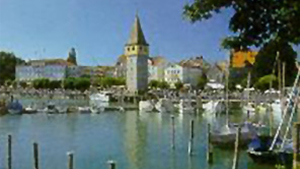 A particularly beautiful area in a cultivated landcape. With a surface area of 539 km², Lake Constance is the third largest lake in Central Europe. It lies on the northern edge of the Alps and marks the border between Germany, Austria and Switzerland.
A particularly beautiful area in a cultivated landcape. With a surface area of 539 km², Lake Constance is the third largest lake in Central Europe. It lies on the northern edge of the Alps and marks the border between Germany, Austria and Switzerland.
Wieskirche
30 km
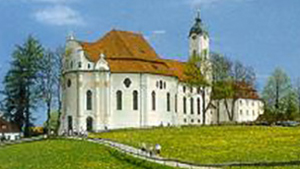 The Rokoko church is a UNESCO-world heritage site. It was built by brothers Dominikus and Johann Baptist Zimmermann between 1746 and 1754.
The Rokoko church is a UNESCO-world heritage site. It was built by brothers Dominikus and Johann Baptist Zimmermann between 1746 and 1754.
Schloss Linderhof palace
approx. 40 km
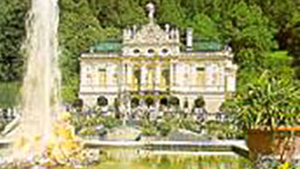 Ludwig II’s smallest palace impresses with its mirror hall and the picturesque park. It boasts an artificial grotto with a wave machine, where the king rode in a rowing boat made of seashells.
Ludwig II’s smallest palace impresses with its mirror hall and the picturesque park. It boasts an artificial grotto with a wave machine, where the king rode in a rowing boat made of seashells.
Ettal abbey
approx. 50 km
The Benedictine abbey was founded in an idyllic setting in 1330 by Emperor Louis, “the Bavarian”. Wander around the beautiful basilica before heading to the abbey’s brewery.
Zugspitze mountain
approx. 50 km
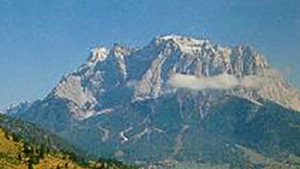 At 2,964 m above sea level, the Zugspitze is Germany’s highest peak. You can reach it with the Bavarian Zugspitzbahn train from Garmisch-Partenkirchen (60 km) or with the Tyrolean Zugspitzbahn from Ehrwald (Austria 50 km).
At 2,964 m above sea level, the Zugspitze is Germany’s highest peak. You can reach it with the Bavarian Zugspitzbahn train from Garmisch-Partenkirchen (60 km) or with the Tyrolean Zugspitzbahn from Ehrwald (Austria 50 km).
